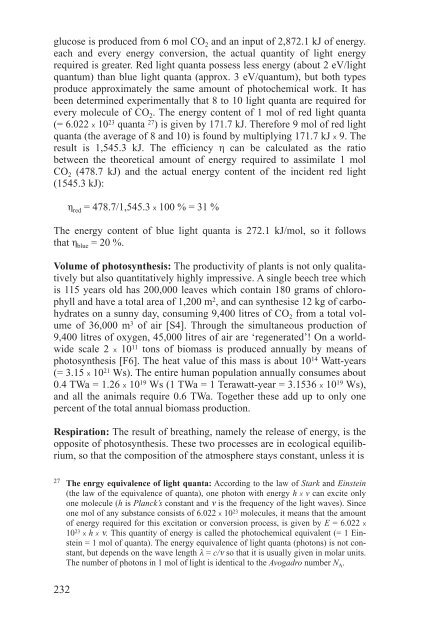In the Beginning was Information
6KezkB
6KezkB
- No tags were found...
You also want an ePaper? Increase the reach of your titles
YUMPU automatically turns print PDFs into web optimized ePapers that Google loves.
glucose is produced from 6 mol CO 2 and an input of 2,872.1 kJ of energy.each and every energy conversion, <strong>the</strong> actual quantity of light energyrequired is greater. Red light quanta possess less energy (about 2 eV/lightquantum) than blue light quanta (approx. 3 eV/quantum), but both typesproduce approximately <strong>the</strong> same amount of photochemical work. It hasbeen determined experimentally that 8 to 10 light quanta are required forevery molecule of CO 2 . The energy content of 1 mol of red light quanta(= 6.022 x 10 23 quanta 27 ) is given by 171.7 kJ. Therefore 9 mol of red lightquanta (<strong>the</strong> average of 8 and 10) is found by multiplying 171.7 kJ x 9. Theresult is 1,545.3 kJ. The efficiency Ë can be calculated as <strong>the</strong> ratiobetween <strong>the</strong> <strong>the</strong>oretical amount of energy required to assimilate 1 molCO 2 (478.7 kJ) and <strong>the</strong> actual energy content of <strong>the</strong> incident red light(1545.3 kJ):Ë red = 478.7/1,545.3 x 100 % = 31 %The energy content of blue light quanta is 272.1 kJ/mol, so it followsthat Ë blue = 20 %.Volume of photosyn<strong>the</strong>sis: The productivity of plants is not only qualitativelybut also quantitatively highly impressive. A single beech tree whichis 115 years old has 200,000 leaves which contain 180 grams of chlorophylland have a total area of 1,200 m 2 , and can syn<strong>the</strong>sise 12 kg of carbohydrateson a sunny day, consuming 9,400 litres of CO 2 from a total volumeof 36,000 m 3 of air [S4]. Through <strong>the</strong> simultaneous production of9,400 litres of oxygen, 45,000 litres of air are ‘regenerated’! On a worldwidescale 2 x 10 11 tons of biomass is produced annually by means ofphotosyn<strong>the</strong>sis [F6]. The heat value of this mass is about 10 14 Watt-years(= 3.15 x 10 21 Ws). The entire human population annually consumes about0.4 TWa = 1.26 x 10 19 Ws (1 TWa = 1 Terawatt-year = 3.1536 x 10 19 Ws),and all <strong>the</strong> animals require 0.6 TWa. Toge<strong>the</strong>r <strong>the</strong>se add up to only onepercent of <strong>the</strong> total annual biomass production.Respiration: The result of breathing, namely <strong>the</strong> release of energy, is <strong>the</strong>opposite of photosyn<strong>the</strong>sis. These two processes are in ecological equilibrium,so that <strong>the</strong> composition of <strong>the</strong> atmosphere stays constant, unless it is27 The enrgy equivalence of light quanta: According to <strong>the</strong> law of Stark and Einstein(<strong>the</strong> law of <strong>the</strong> equivalence of quanta), one photon with energy h x v can excite onlyone molecule (h is Planck’s constant and Ó is <strong>the</strong> frequency of <strong>the</strong> light waves). Sinceone mol of any substance consists of 6.022 x 10 23 molecules, it means that <strong>the</strong> amountof energy required for this excitation or conversion process, is given by E = 6.022 x10 23 x h x Ó. This quantity of energy is called <strong>the</strong> photochemical equivalent (= 1 Einstein= 1 mol of quanta). The energy equivalence of light quanta (photons) is not constant,but depends on <strong>the</strong> wave length Ï = c/Ó so that it is usually given in molar units.The number of photons in 1 mol of light is identical to <strong>the</strong> Avogadro number N A .232











![[Pham_Sherisse]_Frommer's_Southeast_Asia(Book4You)](https://img.yumpu.com/38206466/1/166x260/pham-sherisse-frommers-southeast-asiabook4you.jpg?quality=85)




